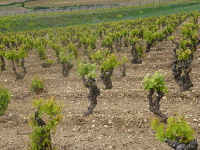

The Campo de Borja region is not necessarily Spain's best known wine producing area, but this D.O. region which lies along the Ebro River valley, just south of the Rioja region, has a long and illustrious history of winemaking. 
D.O. Campo de Borja
History
The earliest documented reference to wines and winemaking in the region are found in the Veruela Monastery archives and date from 1203 when Raimundo Guillén, the fifth abbot of Veruela was the man in charge. This leads historians to believe that the noble grape was cultivated in this area and turned into quality wine well before the 13th century.It seems that the Veruela Monastery was the focal point for the region's winemaking traditions. From the 13th century through to 1835, the monks not only maintained the archives, but also promoted grape production and winemaking techniques; the monastery's cellar was in fact the reference point for the rest of the area's "bodegas".
In 1980, the region was oficially awarded the Denominación de Origen (D.O.) status.
Geography, Climate and Soils
The Campo de Borja region lies in the northwest quadrant of the province of Zaragoza, some 60 km (34 miles) from the city of Zaragoza. Geographically, the region is a transitional zone between the Ebro River valley and the mountains of the Iberian range.The climate is very much continental, the Atlantic being the main influence in winter, where a cold, dry northwest wind known as "cierzo is the key factor. The summer clime, on the other hand, is more affected by warm Mediterranen breezes. This can mean extreme differences between daytime temperatures and those at night, another important influence on the wines grown here. The average rainfall is between 350 and 450 mm.
The area is mainly rolling hills between 350 and 750 meters above sealevel. The soils are moderately rocky with good drainage, rich in organic nutrients, and just right for quality wine production.
The Wines of Campo de Borja
There are some 6,397 hectares (15,800 acres) in the demarcation, which typically produces 20-25 million kilos of grapes each year. 2017 Production: 16,949,100 liters. Rosés and young reds are the predominant wine types, but Campo de Borja bodegas produce qualty whites, cavas, dessert Moscatels, as well as oak-aged red crianzas, reservas and gran reservas.The authorized grape varieties are:
Other grape varieties such as Chardonnay, Merlot and Garnacha Blanca have recently been added to the list of authorized D.O. Campo de Borja varieties.
Red
- Garnacha - 74.55%
- Tempranillo - 11.25%
- Mazuela - 0.22%
- Cabernet Sauvignon - 0.23%
White
- Macabeo - 13.49%
- Moscatel - 0.33%
The region's wines have become available in more markets in recent years, not only in Spain, but also in the export market where 30% of the production is now exported to Europe, North America, South America and Asia.
Other Items of Interest
The region is also of interest for passing tourists. In addition to the obligatory winery tours, there are numerous of historic sites which date from Roman times. The local gastronomy should not be missed and includes: fresh vegetables such as artichokes and asparagus; roast lamb and lamb stew; and "pollo al chilindron" - a stew made from chicken and peppers.One place that shouldn't be missed is the Veruela Monastery, which in addition to being of great historic interest in itself, also houses the Museo del Vino (Wine Museum). The Museo del Vino is the D.O. Campo de Borja's showcase, with a vine garden, wine catalogs, winemaking exposition, an interactive video showing the winemaker's art, and (of course) a wine tasting area.
For more information contact about the Campo de Borja region and wineries contact the Consejo Regulador:C.R.D.O. Campo de Borja
Subida San Andrés, 6
50570 AINZON (Zaragoza)
Tel: 34-76-85 21 22
Fax: 34-76-86 88 06Also a useful interactive map from Rough Guides map of Spain.
Special thanks to the Campo de Borja "Consejo Regulador" who provided the bulk of the data used to prepare this report.
{J.Riis, updated May 2020}